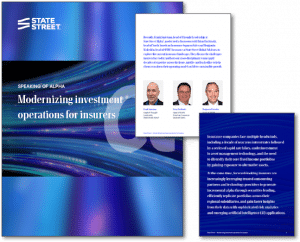In this article, our panelists discuss the challenges insurers face today and how our cross-disciplinary teams apply decades of expertise across the front-, middle- and back-office to help clients transform their operating model and drive sustainable growth.
Insurance companies face multiple headwinds, including a decade of near zero interest rates followed by a series of rapid rate hikes, underinvestment in asset management technology, and the need to diversify their core fixed income portfolios by gaining exposure to alternative assets.
At the same time, forward-looking insurers are increasingly leveraging trusted outsourcing partners and technology providers to generate incremental alpha through securities lending, efficiently replicate portfolios across their regional subsidiaries, and gain faster insights from their data with sophisticated risk analytics and emerging artificial intelligence (AI) applications.
Frank Smietana, head of Thought Leadership at State Street Alpha®, moderated a discussion with Brian Buchinski, head of North American Insurance Segment Sales and Benjamin Woloshin, head of SPDR® Insurance at State Street Global Advisors, to explore the current insurance landscape.
Frank Smietana
Head of Thought Leadership,
State Street Alpha
Brian Buchinski
Head of North American
Insurance Segment Sales
Benjamin Woloshin
Head of SPDR Insurance,
State Street Global Advisors
In what ways are insurance companies leveraging outsourced asset management, and how does that vary based on assets under management (AUM) and asset class?
Ben: It’s dependent on the size of the firm as well as asset class. We can segment insurers based on AUM. Mega is US$50 billion and over, large is between US$10 billion and US$50 billion, medium is US$1 billion to US$10 billion, and small is below US$1 billion. We can further segment based on business line — property, catastrophe, casualty, life and health.
Upwards of 70 percent of insurance companies’ assets are in core fixed income. The megas, large, and mediums mostly manage their general accounts in-house.
The smaller firms will outsource across all asset classes. Where large and mega firms will outsource is in asset classes that they don’t have expertise in or where they believe working with a third party is more efficient. That might include emerging market debt, private credit, infrastructure and private equity.
Brian: While most of the megas manage very large and complex general accounts in-house, it’s also important to note that they offer third-party investment management services to other insurance companies, which is of interest to many asset managers today. On the other hand, at least one large United States-based property and casualty insurer is completely outsourced across multiple managers. That’s part of their strategy and how they want to operate their business. So, it depends on the organization.
“Today, the largest Canadian pension funds, often referred to as the “Maple Eight,” are some of the most sophisticated institutional investors in the world, directly investing in large private market opportunities.”
How does an insurer’s typical core fixed income portfolio differ from other institutional investors?
Ben: Insurers follow an asset liability management (ALM) model to ensure that duration of invested assets matches each business line’s liabilities and timeframe. For example, the liabilities for a life insurer are going to be long dated, in some cases 30-year duration products, while health and auto insurance liabilities are shorter dated. The core fixed income portfolio tends to be high grade corporates, some government bonds, and then — depending on the taxability of the insurance company — we do see insurance companies also investing in municipal bonds or municipal bond ETFs.
All of this is highly dependent on regulatory capital acceptance. In the ETF space, for example, there’s roughly 200 ETFs that have designations issued by the National Association of Insurance Commissioners (NAIC). These are similar to ratings from a nationally recognized statistical rating organization (NRSRO).
US insurance companies are regulated by the states, and most of them accept what the NAIC guidance might be on the ETF. All those other assets need to have either ratings or designations depending on the type of product.
What are some of the different ways insurers are approaching cash management?
Brian: Liquidity is always top of mind for an insurance company, as it is for any other asset manager. How they get that liquidity varies by insurer and strategy. Some firms are active in the repo market or use money market funds, while some choose to hold larger cash balances to ensure easy access to those funds when they need to pay out claims.
On the technology side, an Investment Book of Record (IBOR) provides portfolio managers with an intraday view of cash and positions to enable better informed investment decisions.
Synchronizing with a multi-asset Accounting Book of Record (ABOR) in the back office reduces the need for manual reconciliations and other low-value activities.
70%
Upwards of 70 percent of insurance companies’ assets are in core fixed income.
How are insurers incorporating derivatives into their portfolios, and for what purposes?
Ben: Depending on the insurance company and what exposure they’re looking for, derivatives are used extensively. For example, a life insurance company may be issuing annuities and hedging out the risk.
In the ETF space, we have clients that want exposure to the S&P® 500®, so they may be buying derivatives based on one of the largest ETFs tracking the S&P 500. On the credit side, they typically use CDX as well.
For firms that invest globally, how are they handling their foreign exchange (FX) exposures?
Ben: We’ve seen instances where insurance companies have bought emerging market debt products. If the ETF is denominated in dollars, the FX exposure in that instance wouldn’t be an issue. There are certain insurance companies in the US whose parent companies are in Japan or Germany. They may prefer the FX exposure and not want to hedge it out.
If they’re outside of the US, the insurer is probably going to outsource FX management based on what the exposure is, working with their bank or another hedging counterparty. State Street’s trading desks offer round-the-clock liquidity, hedging expertise, and FX forwards for a broad range of currencies.
“State Street’s trading desks offer round-the-clock liquidity, hedging expertise, and FX forwards for a broad range of currencies.”
In recent years, insurance companies have increased their allocations towards private markets. What challenges are insurers facing in this space?
Brian: A decade of near-zero interest rates pushed insurers into private assets to counter meager fixed income returns. Despite the recent spike in interest rates, approximately two thirds of insurers said they did not plan to alter their allocation plans to private markets, based on our recently published survey. Managing private assets has been a challenge on two fronts.
First, the competition for talent makes it hard to recruit and retain in-house expertise to manage these assets, so insurers tend to outsource that to third-party specialists. Our survey found that only 33 percent of insurers felt they were well developed in building the workforce expertise to evolve with new data systems, technology, and analytical tools.
Second, you can’t use the same technology that you use to manage your core fixed income portfolio. Alternatives require different risk management, accounting, and performance systems.
A surprising number of private assets are still managed using a patchwork of spreadsheets and manual processes. That hinders agility and drives up operating costs for the insurer.
State Street Alpha for Private Markets enables firms to manage the full suite of assets — from private equity and credit to real estate and infrastructure — on a single platform, eliminating reliance on disparate, asset-class-specific systems. Managers can drill down to evaluate individual asset level performance at any level of the fund hierarchy.
Ben: The mega-class companies have robust real estate departments and can do commercial real estate lending on their own. But smaller firms tend to outsource. For most insurers, supporting private assets in-house doesn’t make much sense from a cost and talent perspective if they can outsource at a reasonable price. A lot of top-tier private equity firms have dedicated insurance teams.
They work with mega firms all the way down to the smaller insurers. What’s interesting is that some insurance companies with expertise in private assets offer outsourcing services to smaller insurers.
What additional trends are you seeing across both asset allocation and asset management?
Ben: Because the core insurance portfolio is largely fixed income, low interest rates and rate volatility negatively impact insurers. Sustained high rates are good for asset liability management. At the balance sheet level, our clients are opportunistically looking across the high-yield space and selectively adding to their balance sheets. Collateralized loan obligations, private credit, infrastructure, debt, and assets that generate a consistent cash yield are also of interest.
The other interesting thing we’re seeing, especially in the ETF space, is growing interest in securities lending. There are counterparties in the high yield market that want to establish short positions. Insurers are the logical owner of that ETF and they can generate incremental alpha by lending these assets.
They’ll capture both the yield and the lending premium on those securities as well. We have been a very active player in securities lending and helping insurance companies outsource that activity.
Brian: Another interesting trend we see is the growth of private equity-owned insurance companies, especially life insurers. Many of the largest US-based private equity firms are seeing opportunities in the insurance industry, so they’re buying insurance companies and investing their assets.
Private equity firms tend to invest differently than the insurance company would if they were independent. The ownership structure (mutual vs. stock) of insurance companies can also dictate how they invest due to tax and regulatory considerations.
33%
Our survey found that only 33 percent of insurers felt they were well developed in building the workforce expertise to evolve with new data systems, technology, and analytical tools.
What benefits do ETFs serve in helping insurers manage their portfolios more efficiently?
Ben: In the US market, insurers typically operate under a holding company, and may have multiple operating companies in different states that get regulated differently. It’s difficult for them to replicate their general account or their balance sheet across all those operating entities.
For example, a mega insurance company in New York with US$70 billion in assets might have a US$200 million operating company in Ohio. They need to deploy efficient, low-fee investment vehicles like ETFs to replicate the bigger portfolio with fewer line items.
At State Street Global Advisors, we see a lot of insurance companies using ETFs to gain operational efficiency and scale. This frees up their staff for higher value activities instead of focusing on these smaller subsidiary accounts.
On the equity side, we offer a full suite of ETFs where an investor can get nearly any slice of the market they desire.
Overlaying that is our team of specialists who work closely with insurers to help them effectively leverage ETFs in their portfolios.
How are forward looking insurance firms using data and emerging technologies like AI for better informed investing and underwriting decisions?
Ben: Insurance companies are sophisticated institutions and leverage data in a number of ways. Asset liability management all comes down to a clear and detailed understanding of risk exposures. Due to regulatory reporting requirements, portfolio holdings are publicly available data.
We analyze that data and provide insurance clients with detailed information on what their competitors are investing in, where the gaps are, and how they can align their portfolios with peers.
AI increasingly plays a role in supporting smarter pricing and underwriting decisions. For example, by providing insights into the likelihood of car accidents, percentage of smokers, or propensity for natural disasters in a particular zip code, and then enriching that with third party data, AI can provide differentiated insights into the growth or decline of a particular trend.
“We bring decades of experience in securities lending, helping insurers drive incremental alpha. We also provide a deep bench of expertise across asset classes.
State.”
How can insurance companies leverage our technology, services and expertise to streamline their operating model, grow their business, and gain deeper insights from their data?
Brian: Risk management is at the core of what insurers do. State Street Alpha enables insurers to manage their portfolios and risk exposures across all asset classes — including alternatives — on one, fully integrated front-to-back asset servicing platform. Alpha is built on a modern, cloud-native data architecture, providing investment and operations professionals with a single, enterprise-wide source of truth.
Whether or not assets are custodied or serviced by us, we are able to provide holistic, near real-time data on both internally- and externally managed assets. That visibility is a real differentiator especially during periods of market volatility or constrained liquidity.
Ben: The power of a company like State Street is that we bring decades of experience in securities lending, helping insurers drive incremental alpha. We also provide a deep bench of expertise across asset classes, including bank loans, FX, securitized products, repos and alternatives, all of interest to insurers.
Our Tax Advantaged Beta Strategies group has a number of insurance clients. And we can tailor our mix of services and technology across segments, from mega to small firms and life insurance to property and casualty.
“Firms will outsource asset classes where they believe working with a third party is more efficient.”
70%
Upwards of 70 percent of insurance companies’ assets are in core fixed income.
“State Street’s trading desks offer round-the-clock liquidity, hedging expertise, and FX forwards for a broad range of currencies.”
2/3
Despite the recent spike in interest rates, approximately two thirds of insurers said they did not plan to alter their allocation plans to private markets, based on our recently published survey.
“We bring decades of experience in securities lending, helping insurers drive incremental alpha. We also provide a deep bench of expertise across asset classes.
State.”
33%
Our survey found that only 33 percent of insurers felt they were well developed in building the workforce expertise to evolve with new data systems, technology, and analytical tools.
6090690.1.1.GBL.RTL
The material presented is for informational purposes only. The views expressed in this material are the views of the author, and are subject to change based on market and other conditions and factors, moreover, they do not necessarily represent the official views of Charles River Development and/or State Street Corporation and its affiliates.




